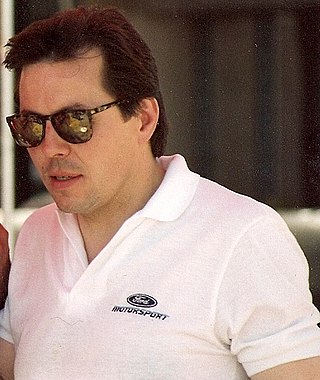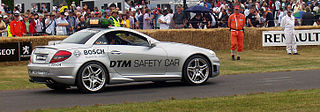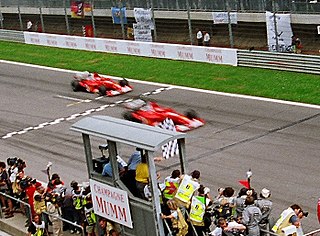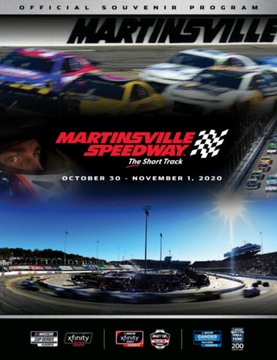
Darrell Lee Waltrip is an American motorsports analyst, author as well as a former national television broadcaster and stock car driver. He raced from 1972 to 2000 in the NASCAR Cup Series, most notably driving the No. 11 Chevrolet for Junior Johnson. Waltrip is a three-time Cup Series champion.

Talladega Superspeedway, nicknamed "Dega", and formerly named Alabama International Motor Speedway (AIMS) from 1969 to 1989, is a motorsports complex located in Lincoln, Alabama, north of Talladega, Alabama. It is located on the former Anniston Air Force Base. A tri-oval, the track was constructed in 1969 by the International Speedway Corporation, a business controlled by the France Family. As of 2023, the track hosts the NASCAR Cup Series, NASCAR Xfinity Series, NASCAR Craftsman Truck Series, and ARCA Menards Series. Talladega is the longest NASCAR oval, with a length of 2.660 mi (4.281 km), compared to the Daytona International Speedway, which is 2.500 mi (4.023 km) long. The total peak capacity of Talladega is around 175,000 spectators, with the main grandstand capacity being about 80,000. As of 2023, Talladega is one of NASCAR's three drafting tracks, alongside Daytona International Speedway and Atlanta Motor Speedway.

Alan Dennis Kulwicki, nicknamed "Special K" and the "Polish Prince", was an American auto racing driver and team owner. He started racing at local short tracks in Wisconsin before moving up to regional stock car touring series. Kulwicki arrived at NASCAR, the highest and most expensive level of stock car racing in the United States, with no sponsor, a limited budget and only a racecar and a borrowed pickup truck. Despite starting with meager equipment and finances, he earned the 1986 NASCAR Rookie of the Year award over drivers racing for well-funded teams.

In motorsport, a safety car, or a pace car, is an automobile which limits the speed of competing cars or motorcycles on a racetrack in the case of a caution period such as an obstruction on the track or bad weather. The aim of the safety car is to enable the clearance of any obstruction under safer conditions, especially for marshals and/or await more favourable track conditions weather-wise. By following the safety car, the competitors' tyres remain as close as possible to operating temperature while their engines do not overheat. A safety car is also preferred over restarting the race as the latter takes longer.

Raymond Donald Evernham Jr. is an American consultant for Hendrick Companies, formerly an auto racing crew chief for Bill Davis Racing and Hendrick Motorsports, owner of his own team Evernham Motorsports from 2001 to 2010, and analyst for ESPN's NASCAR coverage. A three time Winston Cup Series Champion with driver Jeff Gordon, in 1999, Evernham won the NASCAR Winston Cup Illustrated "Person of the Year". Evernham was inducted to the NASCAR Hall of Fame, Class of 2018.

Racing flags are traditionally used in auto racing and similar motorsports to indicate track conditions and to communicate important messages to drivers. Typically, the starter, sometimes the grand marshal of a race, waves the flags atop a flag stand near the start/finish line. Track marshals are also stationed at observation posts along the race track in order to communicate both local and course-wide conditions to drivers. Alternatively, some race tracks employ lights to supplement the primary flag at the start/finish line.

Lawrence Joseph McReynolds III is a former NASCAR crew chief and current racing analyst on Fox Sports as well as a columnist on Foxsports.com. In the past, he has served as an advisor to Petty Enterprises, and as a minority owner in Bang! Racing.

Motorsport marshals are mainly volunteer workers responsible for the safety of motor racing competitors. They are stationed at various points of danger around race tracks to assist them in case of any collisions, accidents or track problems. Marshals are also known as course workers, corner workers, corner crews, turn marshals, corner marshals, track safety workers, or rally marshals.

In motor racing, team orders is the practice of teams issuing instructions to drivers to deviate from the normal practice of racing against each other as they would against other teams' drivers. This can be accomplished either in advance, simply by establishing a pecking order between the drivers within the team, or by instructing a driver to let their teammate overtake or to hold position without the risk of collision.
The National Association for Stock Car Auto Racing (NASCAR) makes and enforces numerous rules and regulations that transcend all racing series.

The 2007 Coca-Cola 600 was the 12th stock car race of the 2007 NASCAR Nextel Cup Series and the event's 48th iteration. It was held on May 27, 2007, with 175,000 spectators in attendance, in Concord, North Carolina at Lowe's Motor Speedway, an intermediate track that holds NASCAR races. Casey Mears of the Hendrick Motorsports team won the 400-lap race after starting 16th. Joe Gibbs Racing's J. J. Yeley finished second and Kyle Petty of Petty Enterprises took third.

The 1992 Hooters 500 was the 29th and final race of the 1992 NASCAR season. It was held on November 15, 1992, at Atlanta Motor Speedway and is widely considered the greatest NASCAR race of all time, with three stories dominating the race: the debut of Jeff Gordon in the Winston Cup Series, the final race of seven-time champion Richard Petty's thirty-five-year career, and the battle for the series points championship with six drivers mathematically eligible to win the title.

Wood Brothers Racing is an American professional stock car racing team that currently competes in the NASCAR Cup Series. The team was formed in 1950 by eponymous brothers Glen and Leonard Wood. From 2006 to 2008, the team was merged with Tad and Jodi Geschickter's JTG Racing. The Wood Brothers Racing Team holds the unique distinction of being the oldest active team in NASCAR, having fielded cars since 1950. They are known for their long relationship with Ford Motor Company, and the long-standing use of the number 21 on their main car. The team currently fields the No. 21 Ford Mustang full-time for Harrison Burton and has a technical alliance with Team Penske.

The 1999 Marlboro 500 Presented by Toyota was held on October 31, 1999, at Auto Club Speedway in Fontana, California as the final showdown of the 1999 CART World Series season. The race was marred by an accident in the early stages of the race which killed Forsythe Racing driver Greg Moore.

Safety in NASCAR has evolved into one of the biggest concerns in stock car racing's largest sanctioning body. Mainly after the death of Dale Earnhardt, a seven time Winston Cup Series champion, NASCAR has decided to change all of their safety policies, such as the use of the HANS device. Since 2001, NASCAR has also changed the cars for the NASCAR Cup Series and the Xfinity Series. NASCAR's safety policy includes the racing fire suit, carbon fiber seating, and roof flaps.


The 2015 Auto Club 400 was a NASCAR Sprint Cup Series race held on March 22, 2015, at Auto Club Speedway in Fontana, California. Contested over 209 laps – extended from 200 laps, due to a green–white–checker finish – on the 2 miles (3.2 km) D-shaped oval, it was the fifth race of the 2015 NASCAR Sprint Cup Series season. Brad Keselowski won the race – his 17th career victory – while Kevin Harvick extended his top two finish streak to eight races with a runner-up finish. Kurt Busch, Paul Menard and Ryan Newman rounded out the top five.

The 2015 Federated Auto Parts 400 was a NASCAR Sprint Cup Series race held on September 12, 2015, at Richmond Raceway in Richmond, Virginia. Contested over 400 laps on the three–quarter (1.2 km) short track, it was the 26th race of the 2015 NASCAR Sprint Cup Series season. Matt Kenseth won the race, his fourth of the season. Kyle Busch finished second. Joey Logano, Aric Almirola and Dale Earnhardt Jr. rounded out the top-five.

The 2020 Daytona 500, the 62nd running of the event, was a NASCAR Cup Series race held on February 16–17, 2020. It was contested over 209 laps—extended from 200 laps due to an overtime finish, on the 2.5-mile (4.0 km) asphalt superspeedway. It was the first race of the 2020 NASCAR Cup Series season.

The 2020 Xfinity 500 was a NASCAR Cup Series race held on November 1, 2020 at Martinsville Speedway in Ridgeway, Virginia. Contested over 500 laps on the .526 mile (.847 km) short track, it was the 35th race of the 2020 NASCAR Cup Series season, the ninth race of the Playoffs, and final race of the Round of 8.




















